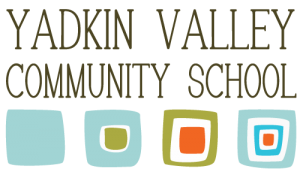From its inception, the Yadkin Valley Community School has been inspired by the Montessori curriculum and philosophy. That means that when you walk into our school, you will notice several ways that it is different than a traditional public school. Our school is committed to a student-centered experience.
“Standards work hand in hand with student-directed learning,” says Elizabeth Stage, codirector for science for the New Standards Project. “A standard is concrete, but there are probably a million ways to meet that standard.”
Here are 10 ways we are making it happen:
- The classroom is set up to meet the students’ needs. Great care is given to make sure that the room looks inviting and that materials are organized. In this student-centered classroom, the children have a choice of where to sit while doing their work. Some sit on the floor and may choose to use a bean bag or cushion. Others like to sit in chairs either at a group table with or at a quieter, individual desk.

- Students, with the guidance of the teachers, make their work plans for the week. This way they have some choices about which works they do on which days. Each Monday, the kids sit around the table and fill out their work plans. If they get everything on their plans finished, there is free time on Friday. This is not free time to play, take a nap or just goof off. It’s time that the kids can decide which areas they would like to explore more deeply. Options include: research on a topic of their choice, doing any of the works on the shelves that would like to do again, writing a story or designing a project of their own.

- In the classroom, there is a lot of discussion and student engagement. One example of this kind of student-led discussion is during reading hour when the kids have their literature (lit) circles. Lit circles give the kids a chance to talk about the book that they are reading through open-ended questions. Their opinions are heard and valued. Some very powerful discussions have come out of these lit circles.

- Each year, our students sign a Classroom Bill of Rights. This is a document includes the rights that the students and teachers agree upon and feel will help our classroom community run smoothly and fairly. It is important to give the students a voice and to help them feel ownership of the classroom. This fosters a real sense of community.
- Each spring, we host an open-house that serves as a “portfolio night”. This is a chance for the students to demonstrate what they have been learning. They choose one of their favorite works, lay it out, and show the parents how it is done. The students feel a great sense of pride while showing their parents the work that they have done. This is also a way to assess what the students have learned in a way that standardized test cannot.

- In addition to the portfolio night, the lower elementary students also let their parents know what they have been working on by writing a letter home each week. This letter is a sweet way for the kids to tell their parents what they are learning and is secretly a language lesson. By the end of the year, the parents will be able to see how their child’s writing has improved including punctuation, capitalization, spelling and content.

- On Friday’s, the teachers meet briefly with each of the upper elementary students to discuss his or her successes and challenges for the past week and goals for the upcoming week. This gives the kids a chance to reflect on what they have done and what they would like to work on. It is important for the kids to set their own goals because this gives them a sense of ownership in their education.

- Failure is part of life and it is part of the learning process. Sometimes design projects, scientific experiments or creative writing assignments don’t go as well as planned. Rather than receiving a poor grade and moving on to the next task, student are given the opportunity to truly learn from their mistakes and make improvements. We teach the importance of the iterative process, a design methodology based on a cyclic process of prototyping, testing, analyzing, and refining a product or process. Based on the results of testing the most recent iteration of a design, changes and refinements are made.

- There are many ways to learn the content that is being taught. Because our school has a Montessori-inspired curriculum, the education follows the student. We meet each child where he or she is and help him or her grow from there using a variety of techniques. For example, multiplication can be learned through skip counting, number puzzles and songs. History can be learned through watching videos, making models, studying ancient cultures through food and art, making maps and story telling.

- The passions and interests of the students are honored and encouraged. The children are given many opportunities to study subjects that are of interest to them. They are also given time to work on projects that they feel passionate about. Some may take that opportunity to learn to play an instrument, write their own book or play, build something in the outdoor construction area, or make a stop-motion animation.

